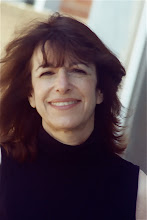
Much has been written about the structure of picture books- the importance of beginnings, middles and ends, plot turning points, rising and falling action.
But what about plotless picture book poems? These books don't depend on conflict, suspense and resolution, yet they still make use of structural logic (beyond their formal aspects, if they're in verse). Poetic books still lead the reader on an engaging journey. The accumulation of scenes/images, set forth in purposeful order, convince us of an emotional truth.
Just look at Liz Scanlon's All The World (illustrated by Marla Frazee), one of last year's critical favorites.
This book is a celebration of the pleasures of nature, and human love. It begins
"Rock, stone, pebble, sand/Body, shoulder, arm, hand/A moat to dig/A shell to keep
All the world is wide and deep."
Notice the organization of this stanza, repeated with variation throughout the book:
-The lists go from big to little
-The imagery moves from the particular in the first line, to the general in the last. Suggesting illustrations that move from close up, to wide angle (and rendered brilliantly by Frazee).
-Also note that the human activity is implied...giving the artist people to illustrate.
From the shore, the poem moves on to gardens, to tree-climbing, and other outdoor delights. When "Morning sun becomes noon blue" the story becomes anchored in time, and subsequently unrolls in chronological order (Frazee depicts one long family excursion).
Then, at midpoint:
"Slip, trip, stumble, fall/Tip the bucket/Spill it all/Better luck another day/All the world goes round this way"
This accident/loss/moment of human weakness (And how real- and reassuring- this moment is, for young children!) shifts the focus in the second half of the book from nature to people, from the outer world to the intimate one. The day draws on, the family comes home to a warm hearth and loving relatives.
In its final verse the poem synthesizes what's come before (the outer and interpersonal worlds) then goes beyond that- to our bonds with humankind:
"Hope and peace and love and trust/All the world is all of us."
This book doesn't have a classical plot, but it's got solid architecture, down to each well-wrought couplet. If you're struggling with your plotless picture book manuscript (in verse or not), consider:
Does your book have structural logic? Does a principle of order (chronological, specific to general, size, distance, quantity, quality, etc.) organize your "scenes" and create movement?
Do you use repetition of words and/or images with variation? Does your ending echo- and deepen- the beginning?
You can also study your favorite poetic picture books, looking for organizing principles and links between the scenes/verses. Would the poem work if these verses were put in random order?








What a great break-down! I think a lot of people look at books like this and wonder why they're so popular because their appeal is much more subtle than a lot of the picture books out there.
ReplyDeleteGreat analysis of an amazing picture book. Thanks, Michelle.
ReplyDeleteThank you so much for this. All the World is one of my all-time favorite PBs, and your analysis enhances my enjoyment of it even more.
ReplyDeleteWhat a nice critique, Michelle! Makes me want to read the book/poem in its entirety...
ReplyDeleteWe get so caught up in thinking a book has to have a plot that we need to be reminded that there are other ways to structure a picture book. Thanks for that reminder.
ReplyDeleteWhat a great post about the structure of poetic picture books. May I excerpt this in an upcoming post on Two Writing Teachers? If that would be okay with you, would you mind sending me an email via our "Contact Us" Page, which can be found at http://twowritingteachers.com/contactus.aspx?
ReplyDeleteThanks Michelle!
Thanks for the feedback. Both readers and writers of this genre would benefit from more study/discussion about it.
ReplyDeleteGreat post, Michelle.
ReplyDeleteThanks for this terrific structural critique!!
ReplyDelete